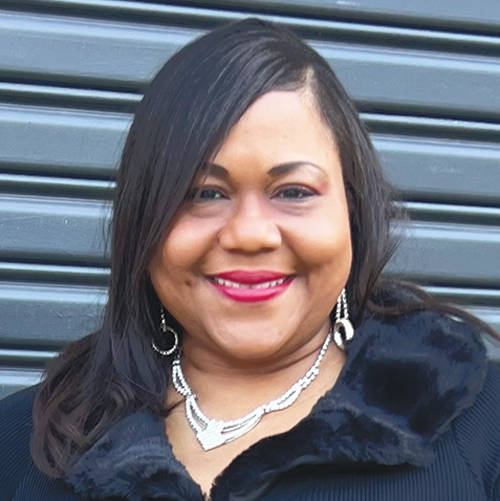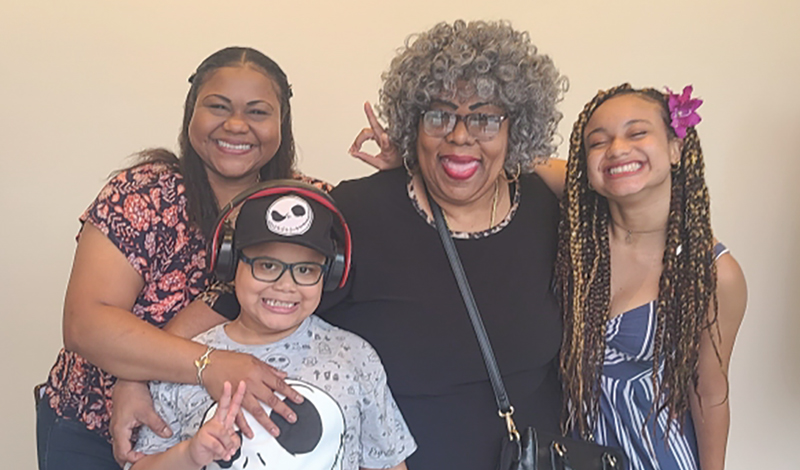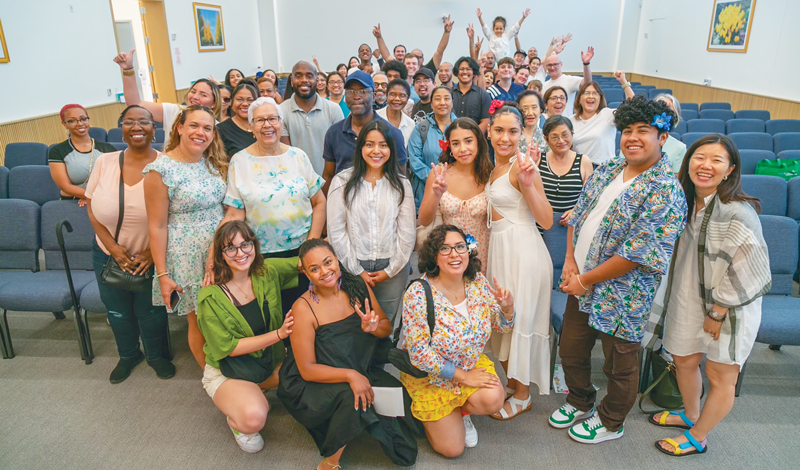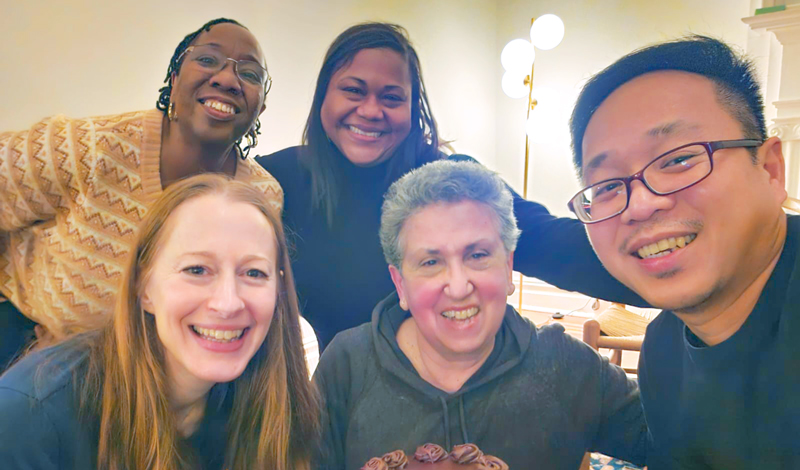With the SGI-USA’s focus on developing the chapter as the headquarters for the community they encompass, the World Tribune sat down with Katty Grant, a chapter women’s leader, to hear about how Roosevelt Chapter is fostering youth.
World Tribune: Thank you for meeting with us Katty, representing Roosevelt Chapter in Queens, New York. We heard of the chapter’s tremendous efforts to raise youth. To start, could you share a bit about yourself?

Katty Grant: My mother started practicing Nichiren Buddhism 42 years ago in Panama while she was pregnant with me. When I was born, the doctors said I would only live for three months, but through chanting Nam-myoho-renge-kyo, my mother was able to find the source of my illness and save my life. From there, I saw her transform her life through dedication to this practice.
As a youth, I always participated in SGI activities. At first, I was just focused on my own benefits, but when I was expecting my first child, I realized the importance of practicing for others. I learned that when I advance kosen-rufu, my own life advances.
In 2017, I moved to New York with my two kids and mother to provide my kids with more opportunities. Since then, it’s been an uphill climb with the language, work and our living situation. But wherever I’ve been, I’ve always jumped into the local SGI community.
WT: We understand it’s been just about a year since you took on leadership in Roosevelt Chapter.
Katty: Yes. I was appointed the women’s leader just days before Ikeda Sensei’s passing last November. It was a tough time for me.
To add to it, many of our active youth graduated with the new year, leaving vacancies in our youth leadership. At first, we were at a loss as a chapter team—the youth weren’t responsive, and we didn’t know how they were doing. We were all struggling with our personal challenges and the reality of our chapter.
When SGI-USA announced that the March Youth Peace Festivals would be held at the chapter level, we knew we had to unite and make a shift. Nichiren Daishonin says, “If the spirit of many in body but one in mind prevails among the people, they will achieve all their goals, whereas if one in body but different in mind, they can achieve nothing remarkable” (“Many in Body, One in Mind,” The Writings of Nichiren Daishonin, vol. 1, p. 618).
It wasn’t about waiting for others or pointing the finger; we each had to stand up first. So, we began chanting and reporting to one another every morning.
WT: How did you set out as a chapter?
Katty: Toward the festival, one young woman agreed to become a point person in planning the activity. Then, with daimoku, another youth responded and started connecting. We created weekly chanting and planning meetings with the two, which became wonderful opportunities to talk and get to know them.
As we shared our progress with the district leaders, everyone grew more enthusiastic about the festival. We created fliers and formed committees for decoration, refreshments and transportation. Above all, everyone did their very best to invite youth.
Our festival brought out 17 members and 39 guests—a total of 56 youth attendees! It was truly an astonishing victory. It showed us the unlimited potential of our youth. As a chapter, we were overjoyed and more determined to raise these precious youth into successors.
WT: Incredible. How did you continue the momentum?
Katty: We were so happy to see these young people emerging but also struggled to care for them without youth leaders. When we sought from a senior in faith about this, they encouraged us to become the “youth leaders” through having a powerful life force. We realized we were looking for youth outside of us, not within ourselves.
We joined forces with district leaders to contact and chant for each young person who attended the festival. We also continued holding youth hangouts, providing opportunities to deepen friendships.
Then, during our Hot Summer Shakubuku campaign, one of the youth shared they wanted to do a dance performance at an upcoming intro-to-Buddhism meeting. We said, “Yes!” and gave them our full support. I saw that our support empowered them to reach out to other youth and take full responsibility for the meeting.
This intro meeting became our biggest hit! We had 32 guests in attendance, with a BBQ, performances, salsa dance lessons and dialogues. One young woman even received the Gohonzon that day.
Since January, we’ve had five new members join our chapter, three of whom are youth. And we also welcomed a new chapter young women’s leader. We have become an ever-youthful chapter, in which new youth are emerging from the earth every month.

WT: Congratulations! What kept you going throughout the year?
Katty: I really love the SGI; I always have. When we first moved to America and were alone, it was the SGI community that held us up.
I have my two kids, and I have people who chant for me and want to see me win. I felt it was my responsibility to show actual proof and repay my debt of gratitude to the SGI and the members. I wanted to ensure that the SGI continues to grow so that my kids and future generations can inherit the conviction that this practice is powerful.
Whenever I felt hopeless, I went to the SGI-USA publications or to Sensei’s guidance in My Dear Friends in America. Every time I did, I found the guidance that I needed. And whenever I felt discouraged, I reached out to my co-leaders or visited the members. Just talking and connecting made me feel better; I didn’t feel alone.
Ultimately, when I just focus on myself, it’s like being in a tunnel with a small light. But when I focus on others, I see so much more beyond my struggles.
WT: What does it look like to expand the network of peace in your local community?
Katty: Every day, I chant for every part of my life to be welcoming to others. I never want someone to feel that they can’t approach me. And wherever I am, I try to be happy, polite and respectful. People are often surprised when I greet them that way. To me, being a reliable and respectful person is the greatest way to share Buddhism.
For example, at work, people have said that they feel a difference when I’m not there. My young co-workers often come to me with their problems, and I’m so happy to connect, share about Buddhism and just be someone in their lives who cares for them.
I also openly share my struggles with everyone so that they can see me transform them. I’m no longer embarrassed or ashamed of my problems. If there’s something I haven’t broken through, it just means I have to do more shakubuku.

WT: This is all very encouraging. What are your determinations toward the one-year anniversary of Sensei’s passing?
Katty: Personally, I have many determinations I’m still striving for: to have a beautiful home for my family where the youth can freely hold activities; to become someone who can touch people’s lives; for my daughter to get into a good college; and for my mom to be healthy.
Last year, I wanted to write to Sensei, but I felt I didn’t have anything worthy of reporting. I deeply regret that I didn’t do so.
This time, I’ll proudly report to Sensei in my heart about the youth standing up in our chapter. I want to assure him: “We will raise many more youth. Our chapter will lead the entire world with propagation, subscriptions and contributions. Not just for numbers sake but because the members are healthy and winning in their lives, and because our districts are strong and filled with appreciation.”
And looking toward the future, I want to be able to say then—I helped many others become happy.

Our Resolve Brings Forth Capable People
Rather than feeling distressed over a lack of capable people in an area, for example, the first thing one should do is offer prayer. To secure peace based on the teachings of Buddhism is the Buddha’s will. It is the Buddha’s enterprise and the Buddha’s work. As Nichiren Daishonin promised, Bodhisattvas of the Earth could therefore not fail to be in any given area, no matter how remote.
The problem isn’t that there are no capable people; it’s simply that we cannot “see” them. The solution is to offer earnest prayer. We also need to be determined to take full responsibility without anyone’s help. Such resolve will without a doubt bring forth people able and willing to work for the same cause.
The Soka Gakkai is an organization of utmost sincerity. That is the meaning of faith.
—Ikeda Sensei, from The Wisdom of the Lotus Sutra, vol. 5, p. 68
November 8, 2024, World Tribune, pp. 8–9
You are reading {{ meterCount }} of {{ meterMax }} free premium articles

